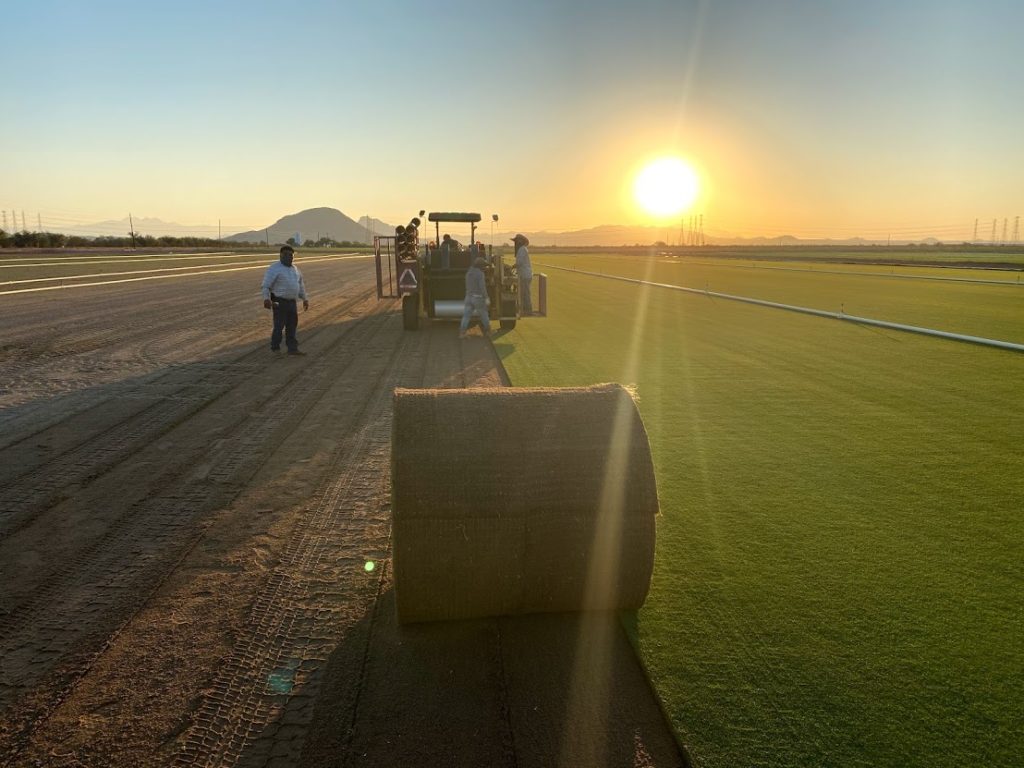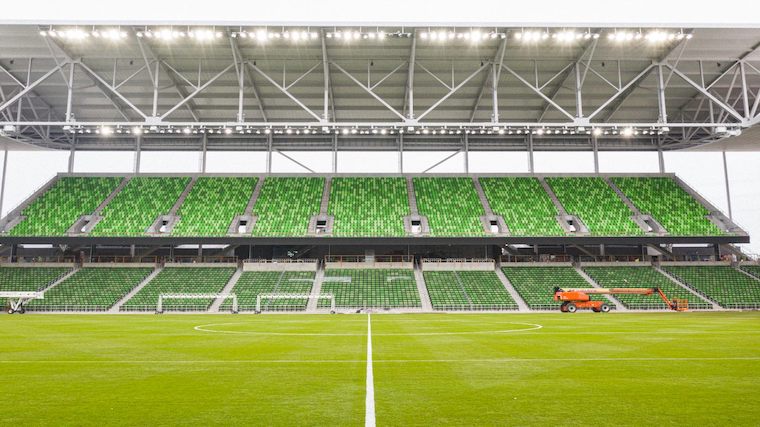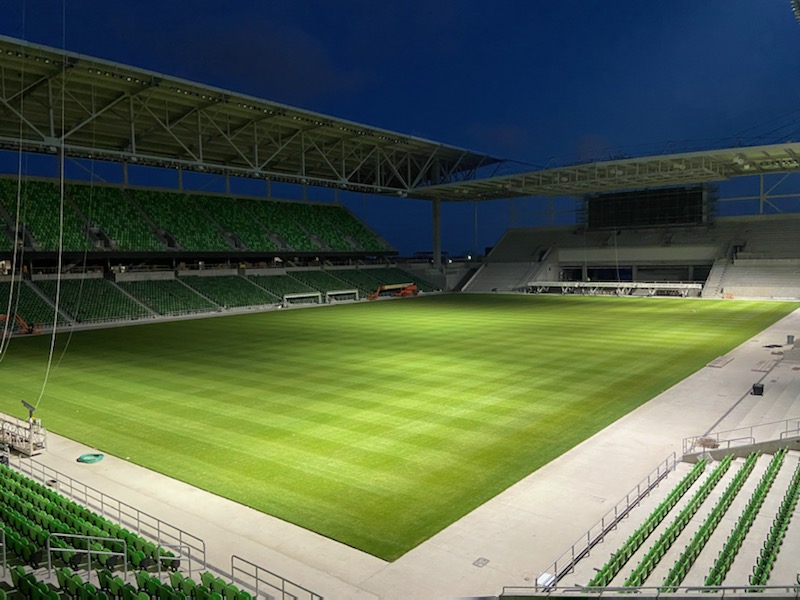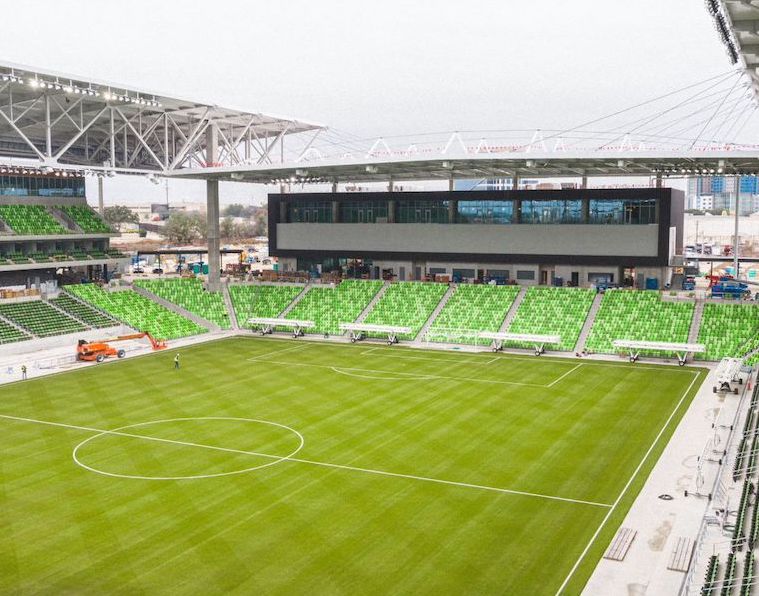By Weston Appelfeller, CSFM
Hi y’all. It has been a little over a year since the last rendition of this series, and I would like to fill you in on what has been taking place. The last article focused on the research that was done in preparation for having grass. This article features the process of building on that research and constructing more than 10 acres of sand-based playing surfaces. We have now installed just shy of 500,000 square feet of turfgrass, and hired two new members to our staff. Things are getting exciting – and busy – here in Austin.
On April 15, 2020, our Platinum TE Seashore Paspalum was planted at West Coast Turf in Scottsdale, Ariz. We chose this grass for one specific reason, its ability to handle shade. We have a 200,000-square-foot roof that overhangs our north and south end field by 5 feet. We have grass growing under a roof. Because we wanted our players to practice on what they will play on, we also grew enough to sod two training facility pitches. We wanted to have a seamless sod layer to rootzone transition, so we had West Coast lay 1.25” of matching rootzone before planting our sod.
Nearly six months after it was planted, the first rolls began getting cut and rolled in Scottsdale. As the first of the refrigerated trucks arrived in Austin, we felt excited and nervous. The sod was being transported from more than 1,000 miles away. We sodded the two pitches at the St. David’s Performance Center (SDPC), our training facility, in early October, and the stadium three weeks later. It took 49 total trucks to get all our sod to Austin.

For the final 1.5 pitches at St. David’s, we chose to use TifTuf bermuda from TriTex turf. These areas will be used as the primary training pitches for our Academy teams. We chose TifTuf due to its ability to handle heavy traffic, its drought tolerance, and its availability in the Austin market. The first Academy pitch was sodded with 0.5”-thick sod rolls of the TifTuf the first week of November, with the half pitch planted the first week of December. We have been pleasantly surprised at how well they have rooted given the dormant planting conditions.
The grass was laid on top of our custom rootzone. We worked with two different field builders, using Sports Construction Group (SCG) at the stadium and Landscapes Unlimited at the SDPC facility. Those groups worked together to source a sand that met the needs we wanted. We added 5% by volume of both Dakota Peat and Profile to help give our sod a good base and offset the drought conditions we will face while still allowing us the ability to drain quickly when we have the seasonal rain that is common in central Texas. We used the same spec’d sand beneath all our surfaces. To aid in the grow-in and promote rooting, we added several products to the soil from Mirimichi Green, Earthworks and The Andersons.
Once the fields were built and the grass was installed, we needed to begin maintenance on these. Our equipment from Toro, Dennis mowers, Inmants, Yanmar Tractors, CoverMaster and a few others begin to arrive. Anyone who has ever built fields on an active construction site understands the challenges. From construction items falling on the field to lifts setting one inch from the edge of your field to having no equipment access because of work taking place near the field, it can be frustrating.
The largest pieces of equipment come from Stadium Grow Lighting (SGL). We purchased seven light rigs from them – five large and two small – and we have had them deployed nearly every day since early November. We also purchased two of their fans and look forward to using those once the Texas heat arrives in the spring. These units are a must have given our shade. Our south 18-yard box has seen very little natural light. We are supplementing this area with an average of 60 hours a week of artificial light.

Our biggest additions came in August and October. In August, we hired Tanner Coffman to oversee turfgrass management at our St. David’s Performance Center. He joined us from Real Salt Lake’s training center, and has been instrumental during the grow-in process. His skillset and knowledge are perfect for that role. Since his arrival, he has been working hard to see that the fields are ready for action in the spring, but he has also been extremely helpful in the construction process. Having him present during the field construction of that facility gave us comfort in what was being constructed.
In October, Luke Bentley joined the club to oversee the grass at the stadium. He joined us from the Mercedes Benz Dome, and had previous experience at Sun Trust Park. His experience working in one of the busiest stadiums in the world and with Platinum TE has been invaluable. He’s been on site at our stadium daily since his arrival, and has been key to making sure all our new investments are working as they are supposed to. The success we will have is due in large part to these two. We look forward to growing the team more during the next several months.

As the research, install and grow-in period is coming to an end, we look forward to the next challenge. Construction is winding down, and we are excited to move into our offices and officially have a place to call home. With practices and matches starting soon, we are working hard to ensure we have everything needed in place. None of the time, research and effort means anything until the fields perform the way they are supposed to, and we need to finish this phase strong.
Thanks for following along. If you have any questions regarding the field building process, please reach out. This has been an unbelievable experience. While sometimes stressful and exhausting, this has been the best two years of my career.


